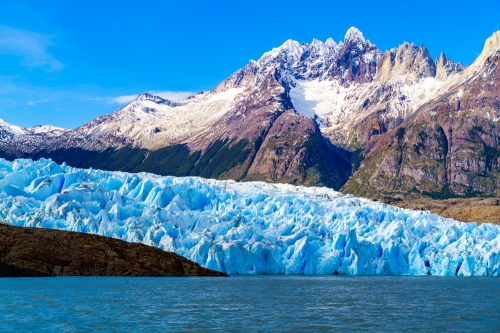The climate and weather in Chile varies depending on which part of the country you are in. Chile’s latitudinal positioning affects its climate patterns, making some areas arid while others enjoy Mediterranean weather. The best time to visit is during the summer, when temperatures are mild.
Chile experiences four different climate patterns by region. The northern area, around the coastline, experiences desert climate, while the inland is semi-arid. The central region of Chile has a Mediterranean climate, while the highlands around the Andes, remain cold throughout the year.Northern Chile is comprised of the coastline as well as parts of Santiago. The entire area is covered by a desert climate, characterized by hot days and cold nights. It barely rains throughout the year because of the Humboldt sea currents that prevent precipitation to form at sea.
Coastal towns such as Antofagasta, Arica and Iquique remain dry throughout the year. Northern Chile is home to the Atacama Desert, which is considered the driest place on earth. At the beginning of the year, between January and February, the northern side of the country experiences hot summer temperatures.
Temperatures in Arica can go up to 23°C between Jan-Feb, and steadily drop to 16°C by June and July. In Iquique, day temperatures oscillate between 21.5°C and 15.5°C. Antofagasta experiences similar high temperatures during the day, fluctuating between 14°C and 20°C.
Sea temperatures at the beginning of the year are very warm; they slowly cool down towards March. During April and October, low clouds known as Camanchacas cover the entire region causing a further drop in day temperatures.
Inland Chile includes towns and cities located away from the sea. This region experiences an arid climate, although the weather bit mild when compared to the coastline. However, certain inland regions such as the Andes do not experience a mild climate. Daytime temperature in regions like these are often much higher the sea-lying areas.
High altitude areas, such as the mountain regions, have a cooler climate. Day temperatures remain high as the sun shines throughout the year. However, temperatures may drop below 0 degrees and frost is likely to occur at night, especially during winter.
Central Chile enjoys the best weather throughout the year. The climate is Mediterranean, characterized by warm summers and mild, rainy winters.
Coastal temperatures in the central region also vary. Sea temperature is cool during summer, with possibility of rain. Day temperatures often rise to 17.5°C at the beginning of the year, and can drop to around 11.5°C as the year progresses.
A large part of Santiago, the capital of Chile, is located within the central zone. Temperatures in January averages around 21°C here. However, summer temperatures may rise further due to pollution from the city and poor air circulation. At these times, temperature may rise to 36°C and 38°C. Nevertheless, day temperatures will begin to drop after March, settling at 9.5°C by June and July. This marks the beginning of winter.
During winter, the central zone experiences a little rainfall. Precipitation in the area averages 375mm throughout the year.
Ironically, southern Chile has the oceanic climate you would expect at the coastline. Day temperatures range from cool to freezing cold, and rainfall is high through the year. Annual precipitation can be as high as 2000mm to 4000mm each year.
It rains in summer, although not as heavily as it does during winter. Rainfall is accompanied by strong gales known as the westerly winds. These winds grow stronger as you move further south. The southernmost part of Chile is also the coldest part of the country. During the rainy season, the entire region is green, especially in the Andes with its vast collection of rain forests.
An interesting phenomenon about the southern region of Chile is that weather patterns will vary according to latitudinal positioning. A town like Puerto Aysen, at a latitude of 45° south, receives annual precipitation of 2250mm. Punta Arenas, at a latitude of 53° south, receives annual precipitation of 430mm. Punta Arenas is blocked from the westerly winds by the Andes Mountains, which explains the drop in precipitation.
Still within the southern zone, there are microclimate regions known as fjords. The weather is extremely cold in the area considering the high altitude of the fjords. Rainfall may be low throughout the year, but glacial erosions are eminent. The climate here is similar to the one experienced in Scandinavian regions, while glacial erosions shape the entire landscape.
As the name suggests, Cape Horn is southern tip of the country. Here the days are mild and the nights are cold from December to February. Day temperatures reach 10°C and drop to below 0 degrees as we advance towards June and July. The southern tip also receives cold waves blowing directly from the Antarctica. These winds will push the freezing temperature further down, until the westerly winds arrive to alleviate the situation.
The best time to visit Chile is during the warm summers that begin from December and stretch towards February. Day temperatures rarely go beyond 20°C, with the exception of the northern region. Santiago City is increasingly becoming a favorite tourist destination with its warm, mild climate that favors outdoor activities.
Traveling to Chile during summer does not require heavy packing; warm clothes and some sunscreen is enough to get you through the sunny days. In winter, add a sweatshirt, jacket, and sweater especially if you are traveling to the northern parts. In central Chile, warm to light clothes will suffice but also add an umbrella for the unexpected rainfall.
If you are travelling to the south, bring warm clothes such as a hat, a scarf and jacket. Add a raincoat as well for the occasional rainfall. High altitude areas such as the Andes will be hot and sunny during the day, while the nights often become a little chilly. Carry some sunscreen, sunglasses, a jacket and hat to be comfortable throughout the season. Add some hiking boots as well if you will be exploring the hilly regions.

